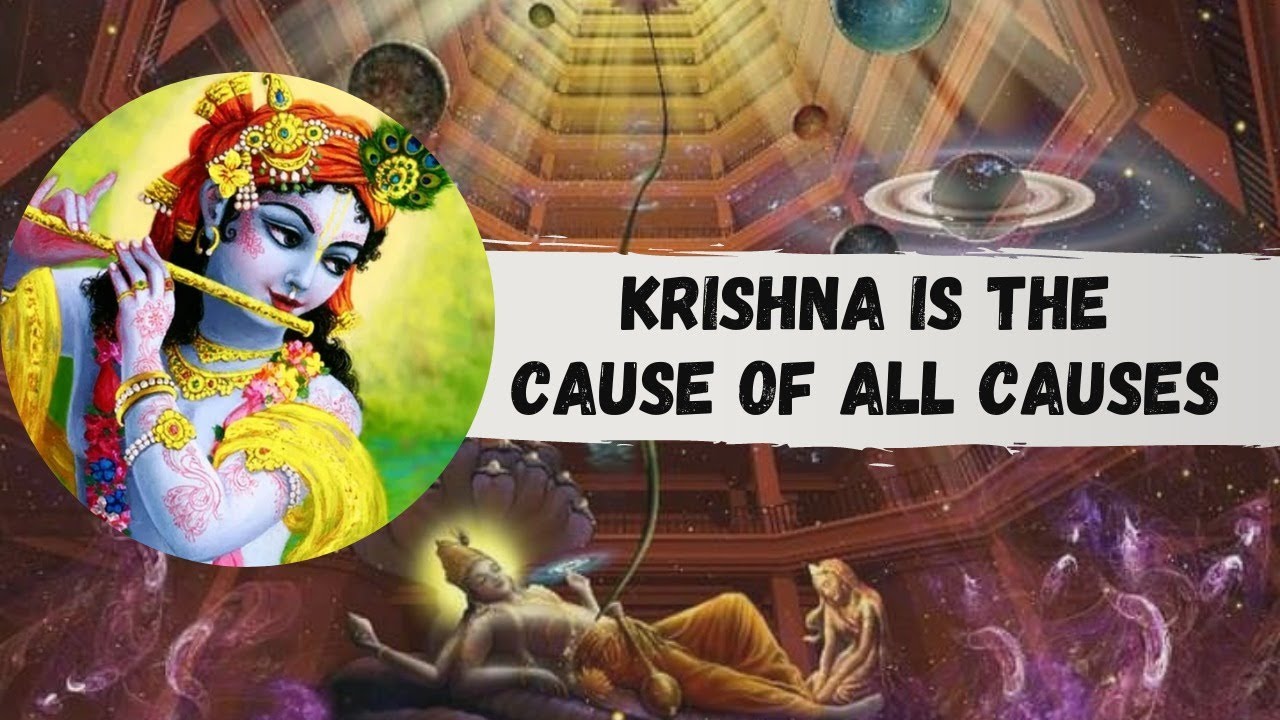Insights from Śrīmad-Bhāgavatam 2.5
The Śrīmad-Bhāgavatam is a timeless treasure of transcendental wisdom. Its Second Canto, Chapter 5, titled “The Cause of All Causes,” offers a detailed exposition of the origin, structure, and purpose of creation. In this chapter, Lord Brahmā, the secondary creator of the universe, enlightens his son and disciple, Śrī Nārada Muni, on the divine process of creation and the Supreme Lord’s role as the ultimate source of all that exists.
This chapter profoundly explains how everything emanates from Śrī Kṛṣṇa and underscores the importance of devotional service (bhakti) in understanding and transcending the material world. Let us delve into the essence of this enlightening chapter.
The Quest for Absolute Truth
The chapter opens with Śrī Nārada Muni seeking clarity from his father, Brahmā. Nārada, a pure devotee and liberated soul, presents profound inquiries:
- What is the ultimate source of creation?
- What is the process behind the manifestation and dissolution of the universe?
- Under whose guidance do all living beings and material elements operate?
Nārada’s questions reflect the natural human urge to understand the purpose of existence and the mystery of creation. These inquiries serve as a foundation for realizing the Absolute Truth (para-tattva), which encompasses three aspects: the impersonal Brahman, the localized Paramātmā, and the Supreme Personality of Godhead, Śrī Kṛṣṇa.
The Supreme Source: Śrī Kṛṣṇa
In response, Brahmā humbly acknowledges that he is not the ultimate creator. Although he is responsible for manifesting the material universe, his power is derived from Śrī Kṛṣṇa, the Supreme Personality of Godhead. Brahmā emphasizes the following points:
- The Lord as the Cause of All Causes
Brahmā explains that the entire creation originates from the Lord’s brahmajyoti (spiritual effulgence), which emanates from His transcendental form. The brahmajyoti serves as the source of all material and spiritual manifestations. This truth is affirmed in the Brahma-saṁhitā :“Govindam ādi-puruṣaṁ tam ahaṁ bhajāmi”
(“I worship Govinda, the primeval Lord, who is the cause of all causes.”) - The Lord’s Role in Creation
Śrī Kṛṣṇa manifests Himself in various expansions to orchestrate creation. Mahā-Viṣṇu, the first Purusha-avatāra, lies in the Causal Ocean (Kāraṇa-jala). From His breathing, innumerable universes emanate. He then enters each universe as Garbhodakaśāyī Viṣṇu and further expands as Kṣīrodakaśāyī Viṣṇu, the Supersoul (Paramātmā) present in every living being and atom. - Brahmā as the Secondary Creator
Brahmā acknowledges that his creative ability is inspired by the Lord. He compares his role to that of a gardener who plants seeds provided by the Supreme. Without the Lord’s guidance, even Brahmā, the first living being, would remain incapable of creation.
The Process of Creation
1. Primary Creation (Sarga)
The Supreme Lord initiates creation by transforming His external energy (prakṛti) through the following stages:
- Mahat-Tattva: The total material energy manifests first as the mahat-tattva, a reservoir of all material ingredients.
- False Ego (Ahaṅkāra): From the mahat-tattva, false ego emerges, categorized into three modes: goodness (sattva), passion (rajas), and ignorance (tamas).
- Five Elements: The material elements—ether, air, fire, water, and earth—develop progressively, each imbued with sensory qualities like sound, touch, form, taste, and smell.
This sequence illustrates the Lord’s systematic and purposeful design, where subtle elements evolve into gross matter.
2. Secondary Creation (Visarga)
Brahmā, empowered by the Lord, takes charge of shaping the universe’s diverse forms of life and matter. Using the elements and qualities provided by the Supreme, he creates:
- Living Beings: 8.4 million species, including humans, animals, plants, and demigods, each receiving a body suited for their karma.
- Planets and Systems: Fourteen planetary systems, ranging from the heavenly realms of Satyaloka to the subterranean Pātāla, are created to accommodate beings of different karmic standings.
Despite his significant role, Brahmā repeatedly emphasizes that all credit belongs to the Lord, whose divine will orchestrates the entire process.
The Virāṭ-Rūpa: The Universal Form
Brahmā introduces the concept of the virāṭ-rūpa, the universal form of the Lord. This representation serves as a meditation tool for those unable to comprehend the Lord’s personal form. In the virāṭ-rūpa:
- The lower planetary systems correspond to His feet.
- The earthly plane is situated at His waist.
- The heavenly planets represent His chest and head.
While this form is an important visualization for beginners, Brahmā clarifies that it is an imaginative conception meant for easier understanding, not the ultimate reality.
The Three Modes of Nature
Brahmā explains the interplay of the three material modes (guṇas)—goodness, passion, and ignorance—which govern the behavior and destinies of all living entities:
- Goodness (Sattva): Associated with purity, knowledge, and harmony. It enables spiritual progress.
- Passion (Rajas): Fueled by desire and activity, it leads to material attachments and restlessness.
- Ignorance (Tamas): Characterized by darkness and inertia, it fosters delusion and degradation.
These modes bind the conditioned soul, trapping them in the cycle of birth and death. Liberation is possible only by transcending these modes through surrender to the Lord.
The Role of Māyā and Illusion
The chapter elaborates on how the Lord’s illusory energy (māyā) bewilders the conditioned soul. Māyā creates a false sense of ownership and identity, leading individuals to think, “This is mine” and “I am the doer.” This delusion perpetuates material suffering.
However, Brahmā assures that māyā cannot influence those who take shelter of the Lord. Devotees who surrender to Kṛṣṇa transcend illusion and attain eternal freedom.
Purpose of Creation
Why does the Supreme Lord create the material world? Brahmā explains that creation serves as a playground for conditioned souls who desire independence from God. The material world offers opportunities for enjoyment and learning through experience. Ultimately, its purpose is to help souls realize their folly, return to their spiritual nature, and reestablish their relationship with the Lord.
The Supreme Goal: Devotional Service
Brahmā emphasizes that devotional service (bhakti) is the ultimate means to attain liberation and realize the Absolute Truth. By engaging in loving service to Kṛṣṇa, one purifies their senses and transcends the modes of nature.
The Bhagavad-gītā (9.27) provides practical guidance:
“Whatever you do, whatever you eat, whatever you offer or give away, and whatever austerities you perform, do that as an offering to Me.”
This verse encourages integrating devotion into every aspect of life, transforming mundane activities into spiritual progress.
Lessons for Modern Civilization
1. Recognizing Dependence on the Divine
Modern society often glorifies scientific advancements as evidence of human independence. Brahmā’s teachings remind us that all achievements are sanctioned by the Lord. Without divine inspiration, even the greatest intellects would be powerless.
2. Unity in Diversity
The virāṭ-rūpa illustrates the interconnectedness of all creation. Recognizing this unity fosters humility, harmony, and a sense of responsibility toward all living beings.
3. Returning to Simplicity
Brahmā critiques the materialistic drive for excessive consumption and artificial needs, which leads to spiritual degradation. He urges humanity to adopt a simpler lifestyle centered on devotion, service, and gratitude.
Conclusion: The Cause of All Causes
The fifth chapter of the second canto of Śrīmad-Bhāgavatam offers a comprehensive understanding of creation, its purpose, and the Supreme Lord’s role as the ultimate cause. Through Brahmā’s teachings, we learn that:
- Śrī Kṛṣṇa is the source of all energies and the creator of all universes.
- The material world is a temporary manifestation designed to help souls return to their spiritual nature.
- Devotional service is the ultimate means to transcend material bondage and attain eternal happiness.
As Brahmā humbly concludes, even his vast intelligence and creative powers are mere reflections of the Lord’s infinite potency. By following Brahmā’s example and engaging in devotional service, we too can align ourselves with the Supreme Lord, the cause of all causes, and attain the ultimate goal of life—pure love for Śrī Kṛṣṇa.
Let us chant the holy names of the Lord:
Hare Kṛṣṇa, Hare Kṛṣṇa, Kṛṣṇa Kṛṣṇa, Hare Hare, Hare Rāma, Hare Rāma, Rāma Rāma, Hare Hare,
and embark on the journey back to Godhead, the eternal abode of bliss and knowledge.




